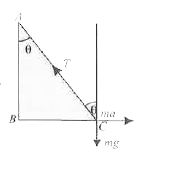A train travelling on one of two intersecting railway lines, subtends at a certain station on the other line, an/ angle when the front of the carriage reaches the junction and an angle when the end of the carriage reaches it. Then, the two lines are inclined to each other at an angle , show that Solution in Punjabi
Step by step video & image solution for A train travelling on one of two intersecting railway lines, subtends at a certain station on the other line, an/ angle alpha when the front of the carriage reaches the junction and an angle beta when the end of the carriage reaches it. Then, the two lines are inclined to each other at an angle theta, show that 2 cot theta=cot alpha-cot beta by Maths experts to help you in doubts & scoring excellent marks in Class 12 exams.
Updated on:21/07/2023Topper's Solved these Questions
- PROPERTIES AND SOLUTION OF TRIANGLES BOOK - ARIHANT MATHSCHAPTER - PROPERTIES AND SOLUTION OF TRIANGLES EXERCISE - PROPERTIES AND SOLUTIONS OF TRIANGLES EXERSISE 1: SINGLE OPTION CORRECT TYPE QUESTIONS
1 Videos
- PROPERTIES AND SOLUTION OF TRIANGLES BOOK - ARIHANT MATHSCHAPTER - PROPERTIES AND SOLUTION OF TRIANGLES EXERCISE - Exercise (Single Option Correct Type Questions)
65 Videos
- PROPERTIES AND SOLUTION OF TRIANGLES BOOK - ARIHANT MATHSCHAPTER - PROPERTIES AND SOLUTION OF TRIANGLES EXERCISE - Exercise For Sesssion 7
10 Videos
- PRODUCT OF VECTORSBOOK - ARIHANT MATHSCHAPTER - PRODUCT OF VECTORSEXERCISE - Exercise (Questions Asked In Previous 13 Years Exam)
52 Videos
- SEQUENCES AND SERIESBOOK - ARIHANT MATHSCHAPTER - SEQUENCES AND SERIESEXERCISE - Exercise (Questions Asked In Previous 13 Years Exam)
38 Videos
Similar Questions
In the adjoining figure, the circle meets the sides of an equilateral triangle at six points.

If AG=2,GF=13,FC=1andHJ=7, then DE equals to
View SolutionIn a ΔABC, if a=13,b=14andc=15, then ∠A is equal to (All symbols used have their usual meaning in a triangle.)
View SolutionIn triangle ABC,a:b:c=(1+x):1:(1−x) where x∈(0,1) If ∠A=π2+∠C, then x equal to
View SolutionLet O be the origin and let PQR be an arbitrary triangle. The point S is such that ¯¯¯¯¯¯OP⋅¯¯¯¯¯¯OQ+¯¯¯¯¯¯OR⋅¯¯¯¯¯¯OS=¯¯¯¯¯¯OR⋅¯¯¯¯¯¯OP+¯¯¯¯¯¯OQ⋅¯¯¯¯¯¯OS=¯¯¯¯¯¯OQ⋅¯¯¯¯¯¯OR+¯¯¯¯¯¯OP⋅¯¯¯¯¯¯OS Then the triangle PQR has S as its
View SolutionLet a,b,c be in A.P. and |a|<1,|b|<1|c|<1.ifx=1+a+a2+....to ∞,y=1+b+b2+....to ∞and,z=1+c+c2+...to ∞, then x,y,z are in
View SolutionIf alpha and beta are acute angles and cot alpha=(1)/(4) and cot beta=(5)/(3)* prove that alpha-beta=45
View SolutionSuppose α,βandthη are angles satisfying 0<α<θ<β<π2. Then prove that sinα−sinβcosβ−cosα=−cotθ
View SolutionIf alpha and beta be the angles subtended by the major axis to an ellipse at the extremities of a pair of conjugate diameters then cot^(2)alpha+cot^(2)beta is equal to
View SolutionIf cot^(2)theta=cot(theta-alpha)cot(theta-beta), then show that cot2 theta=(1)/(2)[cot alpha+cot beta]
View SolutionFrom the bottom of a pole of height h the angle of elevation of the top of a tower is alpha and the pole subtends an angle beta at the top of the tower . Prove that the height of the tower is (h cot(alpha - beta))/(cot(alpha - beta) - cot alpha) .
View SolutionIfsin(α−β)sinβ=sin(α+θ)sinθ,<br> prove that cotβ−cotθ=cot(α+θ)+cot(α−β)
View SolutionIf cot2θ=cot(θ−α)cot(θ−β), prove that cotα+cotβ=2cot2θ
View SolutionA train travelling on one of two intersecting railway lines, subtends at a certain station on the other line, an angle α when the front of the carriage reaches the junction, and an angle β when the end of the carriage reaches it. Prove that the two lines are inclined to each other at an angle θ determined by 2cotθ=cotα−cotβ.
View Solutioncot2θ=cot(θ−α)cot(θ−β) হলে দেখাও যে, cotα+cotβ=2cot2θ
View SolutionA plumb line gets inclined to vertical at angle θ when the carriage travels with an acceleration a. The plumb line is suspended from the roof of the carriage. The acceleration a is given by

View Solutionযদি α ও β কোণ দুটি পরস্পর পূরক কোণ হয়, তাহলে দেখাও যে, cotβ+cosβ=cosβcosα(1+sinβ)
View Solution
